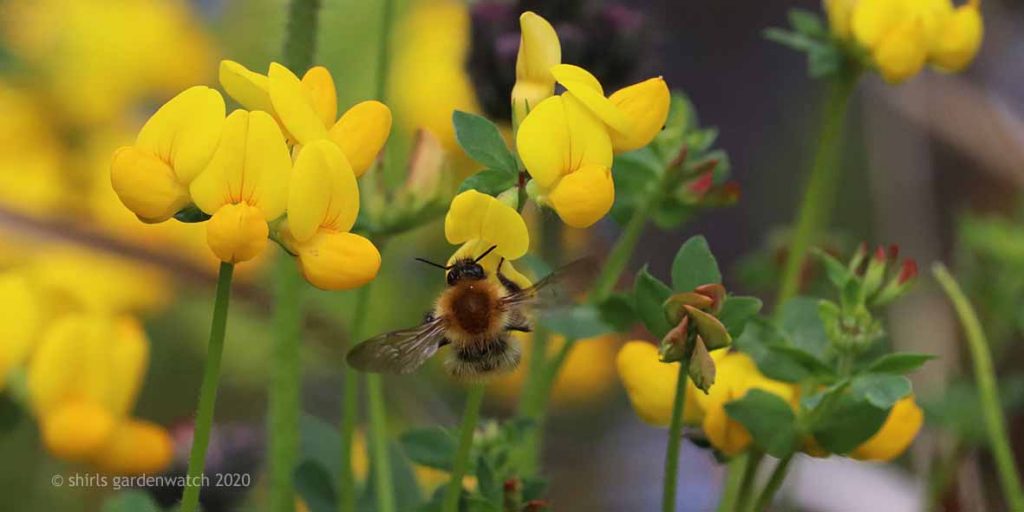
My plants person’s garden slowly migrated to more of a wildlife garden in my early years of blogging. Regular wanders with a camera for blog photos, had me noticing more. I was looking at the garden at an entirely different pace with different eyes. As I posted on my observations of birds visiting the feeders, put up for my daughter’s school bird project, I found myself wanting to learn more about them. What excitement there was when something new arrived in the garden. There still is, all these years on. The garden just keeps on giving too.
The biggest change to garden plantings are the flowers for pollinators that now dance about in the breeze. It’s a fun challenge trying to photograph bees and butterflies feeding on them. I still find myself wanting to capture records of anything that visits the garden, even if I have done so before. Loosing time standing with a camera is easy, but it’s not time wasted, far from it. Time outdoors connecting to nature makes you feel good, I always feel recharged even after a short spell. It’s great this is now more widely recognised and is promoted more.
It’s been a fun challenge gardening for wildlife without having a truly wild garden with weeds and long grass. I did briefly try the latter but it spread to gravel paths. I get completely that proper wild spaces support the biggest diversity of wildlife, that’s a given. I wholeheartedly support that but it wasn’t for me – although the weeds have other ideas. I have always loved wild flowers and already had them planted among cultivated plants in the borders. The bees really enjoy one of my favourites, the bird’s foot trefoil in the image above. It makes me smile and remember my childhood walks every time I see them visit it.
I am very happy that hedgehogs can enter my garden, under hedges and a garden gate. There is is plenty of ground cover for it it to forage. Patches of bare soil are available in my, stuffed with plants, borders for it, birds, bees and anything else that uses it. There is a hedgehog feeding station with a camera discretely buried in a garden border. I’m delighted to say, it gets well used. There are two ponds, one very small the other a small/medium wildlife one with a shallow edge for wildlife to get in and out. A camera overlooks the pond, two seating areas do too. This area is a magnet for both wildlife and the family.
Small trees, a variety of Acer types, a homemade feeding station of tall posts with branches bolted on and shrubs keep birds relatively safe from predators like cats and the Sparrowhawk, mostly. Feeders and tables are located nearby as obstructions whilst keeping the space open at the same time. Inherited garden stones and imported sandstone rocks dug up in fields by a local farmer are used throughout the garden. I have always loved working with stone and enjoyed being creative with it in the borders. Grouped together as features they also afford cover for newly emerged newts, mice and many other insects. Snails are attracted to the rocky crevices too, as are bees.
Size wise, the garden would be classed as small. I have always been incredibly grateful to have had enough garden space to make new borders. The house has a corner location making the front garden area smaller, it is also shared with car parking. A long slim triangle shaped, sun baked, raised border is the main front garden area. I treat it like a giant planter. Although, I don’t move things about there, not too much anyway. There is also a smaller raised area near a window and planters by the door.
The back garden surrounds the house on two sides and is more ‘L’ shaped. It is partially shaded throughout the day. It’s longest two lengths have a, well looked after, Leylandii hedge. There is fencing on two other sides. There are a number of vertical structures in the back garden including a pergola which make the garden feel bigger as there are many routes through it over paving, gravel and grass. Climbers include ivy, golden hop, clematis, honeysuckle and a white Chinese wisteria which hasn’t outgrown its space on the pergola. Bees love the pea shaped flowers of the wisteria.
Thanks for stopping by, this is a bit longer a summary than I intended. My intention here is to give a general overview of the garden to support blog posts that may have brought you here. I am seriously astounded at how much wildlife can be attracted to an ordinary garden at the end of a street, if you make a few changes. I would absolutely recommend experimenting with ideas to attract wildlife to your garden. It’s fun being creative outdoors, but when you see what you try/build being used, it’s just brilliant!